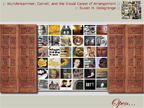When Revision Is Redesign: Key Questions for Digital Scholarship
Susan H. Delagrange
Disambiguation
Q: In multimodal, multilinear media, how can the often competing scholarly obligations to be clear and unambiguous and to promote inquiry and discovery be balanced?
A major concern of the Kairos reviewers was the often ambiguous relationship between the images and the text. I rarely referred specifically to the images, nor did I explain the connection between the images and the words called out in red in the text. "I...didn't know, at first, what the point of the images were. Some situating would help," wrote one reviewer, while acknowledging that "I know this conflicts with the purpose of your argument." And in their revise-and-resubmit letter, Kairos editors Cheryl Ball and Beth Hewett wrote, "Some of the lexias need to be grouped together for the readers to see your meaning."
I agreed with the suggestion that lexias be grouped, and reduced the number of screens from 60 to 36, which made the written text easier to read and comprehend. But it was also necessary for my argument that viewers see meaning first through the visual components, and that they engage with the interpretation of those visual elements without an intervening verbal explanation.
To illustrate: The animation on the right plays automatically when the viewer chooses the lexia "Metaphor/Metonymy/Synecdoche" (to see the animation here, click on the button, bottom left). The text associated with this animation reads in part, "Metaphor draws upon the participatory aspect of analogy, that if two things are similar in some ways, then it is likely that they will be similar in others, an insight that is critical to the formation of community." Because the animation continues to play, the viewer has time to think about what the relationships are between the running horse superimposed on the one-way street sign and the blooming and dying, blooming and dying plant superimposed on the traffic circle street sign, and then to further reflect on the connections between the first and the second juxtaposition. |
Metaphor animation Metaphor/Metonymy/Synecdoche lexia (Delagrange, 2009) |
The Wunderkammer is an object-to- think-with that constructs an uncanny bridge between the mental and physical; it en- genders wonder, a productive aporia between not-knowing and knowing.
I designed the animation to explore time as a metaphor, and to visualize the conceptual difference between time as an arrow, forever streaming out behind us, and time as a circle, repeating cycles of birth, death, and renewal. But by explaining, I undercut my argument that visual arrangement, juxtaposition, classification, and even serendipity are in themselves generative, epistemologically rich and powerful. And by explaining, I also inhibit the opportunity for new, different, and equally productive interpretations of the images to emerge.
This is part of what Larry Leifer, director of the Stanford Center for Design Research, called design thinking (2007). He argued that a key to innovative thinking and problem-solving is maintaining ambiguity for as long as possible. Designers must preserve ambiguity so as not to exclude avenues of thought or experiment that might later prove productive. Learners too must preserve ambiguity, as premature certainty shuts down the process of inquiry and exploration that often leads to more sophisticated, more interesting, more generative knowledge.
By remaining deliberately enigmatic (much as the objects in a Wunderkammer are enigmatic, acquiring their meaning only through the cognitive and emotional associations constructed by the viewer), the images enable the viewer to confront the experience of aporia, of being on the edge of understanding, as well as the Aha! experience of discovery, that ground a heuristic of visual arrangement as invention.
